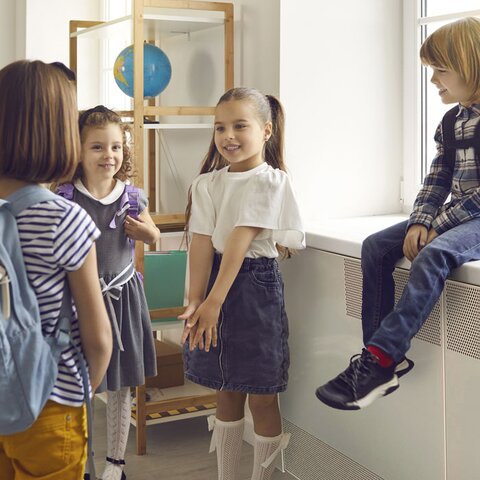
WiVent-B Ventilation unit
The decentralized ventilation unit WiVent-B was developed for optimal ventilation in schools and educational facilities. The WiVent-B is characterized by its particularly energy-efficient operation. The very low electrical power consumption is accompanied by a high heat recovery rate. This allows healthy indoor air to be achieved with low operating costs.
Technical details
- Ventilation unit for use in schools, educational institutions, conference rooms
- Simple and effective: ventilation, cooling, and heating with just one unit
- Demand-controlled regulation with CO2 sensors or room temperature sensors
- Optimal air quality ensures a comfortable indoor climate
- Cost-efficient thanks to particularly energy-efficient operation
- GLT interface for easy integration into building management systems, central access to operating modes and room parameters, and reading of operating statuses
- Hygiene certificate
Declarations & proofs

Product details
The decentralized WiVent-B ventilation units are so-called facade ventilation units and are used in particular in schools, educational institutions, or conference rooms. They are installed horizontally under the window sill or under the window parapet.
After connecting the units to the existing heating pipes, the ventilation units also take over the heat supply beyond heat recovery. If sufficiently dimensioned, the radiators in the room can be removed.
The decentralized WiVent-B ventilation units have a high-quality surface finish and can be integrated into any room as a ventilation strip consisting of several units or as a single, individually clad unit, depending on requirements, in an attractive and space-saving manner.
Decentralized ventilation unit with heat recovery
The decentralized ventilation unit WiVent-B for schools and educational institutions is characterized by its particularly energy-efficient operation. The very low electrical power consumption combined with a high heat recovery rate form the basis for particularly low operating costs.
The efficiency of our decentralized ventilation unit is further increased by demand-dependent control. CO2 sensors and room temperature sensors provide reliable measurement results and the necessary control parameters for optimum and stepless control of the supply air volume flows into the room.
Source and mixed air flow
The feasibility of a genuine supply air flow for normal operation and the option of generating a mixed air flow for heating ensure that ventilation with WiVent-B ventilation units can always be optimally adapted to the requirements of the room. Maximum comfort and a pleasant indoor climate for the room user are the focus, guaranteeing the best air quality.
Operating modes
Different operating modes make it possible to adapt the operation of the ventilation units individually to the usage profile of the room. By taking advantage of cooler night-time temperatures, the night ventilation mode ensures efficient cooling of the room temperature, thus providing the basis for a pleasant start to the school day.
WiVent-B unit variants
The decentralized ventilation units WiVent-B are manufactured as both master and slave variants. When several units are used, a master unit controls the slave units.
Product markings
The decentralized ventilation units WiVent-B have a certificate for hygiene in ventilation technology issued by an independent institute.
The advantages of WiVent-B
- The low-turbulence supply air flow allows ventilation with increased ventilation effectiveness while maintaining all comfort parameters.
- Room-by-room ventilation prevents the transfer of exhaust air from one room to the supply air of another room – no recirculation / no recirculation mode.
- The highly effective heat recovery transfers the heat from the exhaust air to the supply air. The energy used for room heating is thus reused and increases energy efficiency.
- The windows of the room can still be used. Window contacts switch off the decentralized ventilation units when the windows are open.
Technical specifications
Not all variant values listed here can be combined with each other.
| Basic version |
|
| Width |
|
| Height |
|
| Connection position |
|
| Heating and cooling unit |
|
| Heat exchanger |
|
| Outdoor air filter |
|
| Exhaust air filter |
|
| Condensation discharge |
|
| Room control unit |
|
| Colour |
|
Media & Downloads
FAQ
Thanks to the changeover flap [1], ventilation can either take place across the entire width of the appliance or via a reduced outlet cross-section. This means that the air is either distributed with low momentum and low flow velocity or with high momentum and far into the room.
In addition to heat recovery, there is a water-led heating coil [2], which provides sufficient heating even on cold winter days and thus even replaces the radiator.
The water-led cooling coil [3] is optional and ensures a pleasant room climate on hot summer days.
For a large part of the year, heat recovery is completely sufficient to optimise the temperature of the fresh outside air without additional heating energy. For this purpose, the bypass [5] regulates the supply air temperature to the ideal level.
The WiVent-B is equipped with the latest fan technology [6], which is characterised by infinitely variable control and EC motor technology [6] with backward curved blades for maximum efficiency.
To maximise well-being, the air flows out across the entire width of the appliance [4] and slows down after leaving the appliance. The information obtained from separate room air sensors is used to control the air flow rate as required. The CO2 concentration serves as a control parameter for the room air quality.
WiVent-B is very easy to configure, parameterise, operate and monitor. Analogue or digital room control units, as well as web-based visualisation via PC, tablet or smartphone, make controlling the WiVent-B a pleasure. Schedules in the form of typical daily and weekly sequences can also be flexibly customised.
The modular design allows easy access to all components once the appliance has been opened. This means that all surfaces and airways can be visually inspected without any problems. If necessary, the completely hygienic design enables quick and easy cleaning.
The WiVent software provides various operating modes for flexible organisation of ventilation operation. Many operating modes allow scheduling with regard to typical daily and weekly sequences. In addition, all operating modes can be customised to the needs of the user via parameters.
Absence times can also be set up by the day and to the minute. This is possible by using Microsoft Excel tables. For example, the decentralised ventilation system can be set differently for holiday periods. All tables for the holidays of the German federal states can be found in our Wildeboer download area in the "Information material" section.
The rooms to be ventilated should have a connection to the facade so that outside and exhaust air can pass through. For optimal ventilation of the room, enough space for installation should be considered and a room depth of 8 m should not be exceeded.
Ventilation of the room via the windows is possible at any time. Window contacts can be used for this purpose, which switch off the ventilation unit as soon as the window is opened. As soon as the window is closed again, the ventilation operation restarts automatically.
The installation of a room control unit is not mandatory, but recommended, as this allows the individual needs of the user to be addressed on site. In addition, it is of course also possible to make these adjustments via the web interface.









